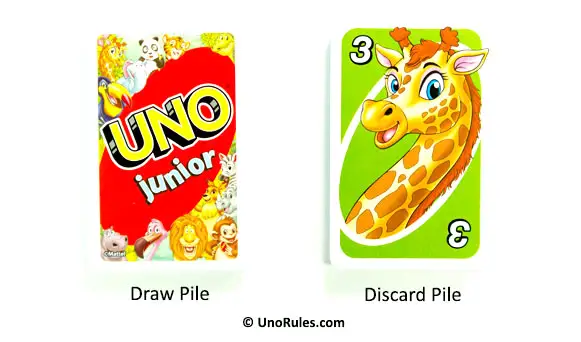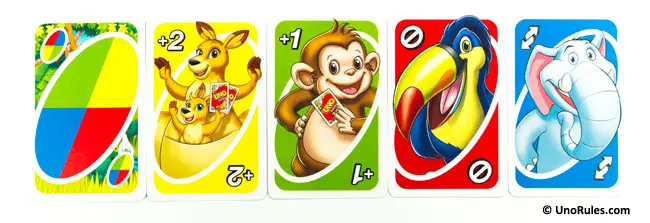
Uno Junior is a relatively new version of Uno that is dedicated mainly for small kids around 3-5 years of age. As a result, the game is simpler compared to standard Uno, with a somewhat different set of cards and rules. Read on to learn all about Uno Junior rules!
There are only 56 cards in a deck of Uno Junior, which is half that of a standard Uno deck (reflecting its simplicity). And there are 3 levels of play in Uno Junior (Beginner/Intermediate/Advanced). As with all Uno versions, the goal of the game is to get rid of all the cards in your hand before anyone else.
Uno Junior is a great game to teach young children about taking turns, recognizing colors, numbers (and some animals), thinking logically, critically, and learning how to sort objects/motifs and solve simple problems.
Gameplay
Choose a dealer, either an adult who can supervise the players, or get the players to pick a card each from the deck, and the one with the highest numbered card gets to be the dealer (any other card that is not a numbered card counts as a zero).
Shuffle the deck well, and then deal out 5 cards to each player. The remainder of the deck is placed face down and becomes the Draw pile where players will draw cards from. Turn over the top card from the Draw pile to form the Discard pile. This is the pile where all the players match and put down their cards.

Uno Junior Draw and Discard piles. When playing for the first time, try to explain these piles and their functions to your child.
Normally, the first player to begin their turn is the player to the left of the dealer. And the turns will initially move in a clockwise direction until changed later on by a Reverse card.
For the first player, try to match the card on the Discard pile with a card in their hand. Cards can be matched by:
- Color
- Number
- Animal
Example: If the Discard pile card is a Blue Panda with number 5, then you can match it with either a blue colored card, or a card with number 5, or a Panda card of any color or number. Once you match it, put down that card onto the Discard pile and complete your turn.
If you have no suitable card to match the Discard pile card, then draw ONE card from the Draw pile. If it can match the Discard pile card, you can play that card right there and then. Otherwise, you can also choose not to put it down and finish up your turn (but remember the goal of the game is to get rid of all your cards!).
Play then moves on to the next player in the turn order, and this goes on and on, until someone gets rid of all their cards.
Remember to yell “Uno!” when you are down to your last card. Otherwise, another player can catch you for that (before another player begins their turn) and then you have to draw 2 additional cards as a penalty!
Action Cards
The Action cards in Uno Junior are slightly different compared to standard Uno. You don’t have to include them in the game if you are not intending to play the Intermediate or Advanced level (more about the Levels in Uno Junior shortly). Unlike other Uno versions, there are no Wild Draw Four cards in the game.

Uno Junior Action cards. From left to right: Wild card, Draw Two card, Draw One card, Skip card, and Reverse card.
Draw One card – When you play this card, the next player must draw 1 card from the Draw pile and skip their turn. This card can only be played to match another Draw One, or another card of the same color, or another similar animal. If turned up at the start of play as the first card of the Discard pile, the first player must draw 1 card.
Draw Two card – When you play this card, the next player must draw 2 cards from the Draw pile and skip their turn. This card can only be played to match another Draw Two, or another card of the same color, or another similar animal. If turned up at the start of play as the first card of the Discard pile, the first player must draw 2 cards.
Reverse card – When played, the direction of play reverses. If the direction of play was clockwise, then it becomes counter-clockwise, and vice versa. This card can only be played on another Reverse card, or a card of the same color, or another similar animal. If turned up at the start of play as the first card of the Discard pile, the Dealer becomes the first player instead, and play moves in a counter-clockwise direction until it gets changed by another Reverse later on.
Skip card – When played, the next player must miss their turn. This card can only be played on another Skip card, or a card of the same color, or another similar animal. If turned up at the start of play as the first card of the Discard pile, the first player gets skipped.
Wild card – You can play this card on any turn and it doesn’t matter what color or number (or animal) is in play at that moment. When you play this card, call out what color will continue play, as the Wild card can represent any color. If turned up at the start of play as the first card of the Discard pile, the first player will choose a color to continue the game and gets to play a card from their hand with that chosen color.
Uno Junior Levels
Uno Junior is designed with “levels” in mind that can be adjusted depending on the age of your child. This is to make the game an enjoyable experience for these young ones while helping them develop their mental cognitive abilities.

Uno Junior cards are nicely illustrated and designed.
- Beginner level – To play the Beginner level, simply remove ALL the Action cards.
- Intermediate level – To play the Intermediate level, simply add the Skip, Reverse, and Wild cards to the deck.
- Advanced level – To play the Advanced level, simply add the Draw One and Draw Two cards, so that now, you are playing with the FULL deck of 56 cards.
Winning the Game
You win the game when you manage to discard ALL your cards before anyone else. Just remember to yell out “Uno!” aloud, when you are down to your last card! Uno Junior does not have any scoring system, so the cards don’t count for any points that need to be tallied up at the end of the round, unlike other Uno versions.